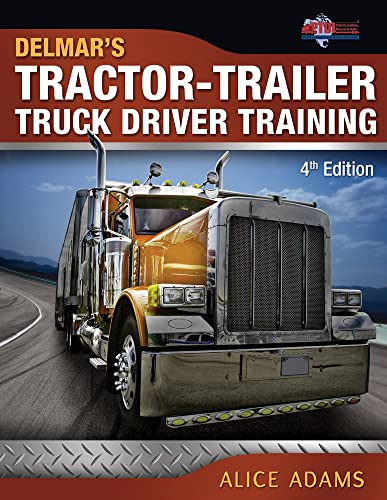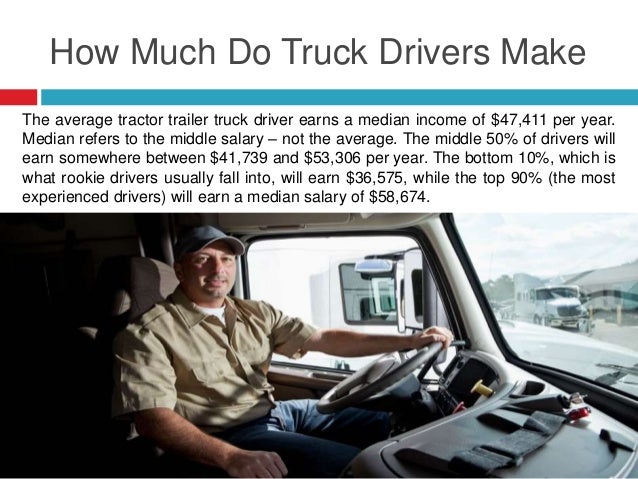Tractor Trailer Truck Driver Training
Please enable javascript to play this video. Quick Facts: Heavy and Tractor-trailer Truck Drivers$43,680 per year$21.00 per hourPostsecondary nondegree awardNoneShort-term on-the-job training1,958,8005% (As fast as average)99,700Heavy and tractor-trailer truck drivers transport goods from one location to another.Working as a long-haul truck driver is a lifestyle choice because these drivers can be away from home for days or weeks at a time.Heavy and tractor-trailer truck drivers usually have a high school diploma and attend a professional truck driving school.

They must have a commercial driver’s license (CDL).The median annual wage for heavy and tractor-trailer truck drivers was $43,680 in May 2018.Employment of heavy and tractor-trailer truck drivers is projected to grow 5 percent from 2018 to 2028, about as fast as the average for all occupations. As the demand for goods increases, more truck drivers will be needed to keep supply chains moving.Explore resources for employment and wages by state and area for heavy and tractor-trailer truck drivers.Compare the job duties, education, job growth, and pay of heavy and tractor-trailer truck drivers with similar occupations.Learn more about heavy and tractor-trailer truck drivers by visiting additional resources, including O.NET, a source on key characteristics of workers and occupations. Some heavy and tractor-trailer truck drivers plan their own routes.Heavy and tractor-trailer truck drivers transport goods from one location to another. Most tractor-trailer drivers are long-haul drivers and operate trucks with a total weight exceeding 26,000 pounds for the vehicle, passengers, and cargo. These drivers deliver goods over intercity routes that sometimes span several states. Some truck drivers travel far from home and can be on the road for long periods at a time.Heavy and tractor-trailer truck drivers held about 2.0 million jobs in 2018.
The largest employers of heavy and tractor-trailer truck drivers were as follows: Truck transportation45%Wholesale trade11Manufacturing7Self-employed workers6Construction6Working as a long-haul truck driver is a lifestyle choice because these drivers can be away from home for days or weeks at a time. They spend much of this time alone. Driving a truck can be a physically demanding job as well. Driving for many consecutive hours can be tiring, and some drivers must load and unload cargo. Injuries and IllnessesBecause of the potential for traffic accidents, heavy and tractor-trailer truck drivers have one of the highest rates of injuries and illnesses of all occupations.
Work SchedulesMost heavy tractor-trailer drivers work full time. The regulates the hours that a long-haul truck driver may work. Drivers may not work more than 14 hours straight, comprising up to 11 hours driving and the remaining time doing other work, such as unloading cargo.
Epson driver free download. Epson L210 Drivers latest version: Take control of your Epson L210 printer. Epson L210 Drivers is the official driver pack for Epson L210 series printers. And follow the instructions on the screen; the drivers more or less install themselves. Innovation Sponsorships Newsroom Contact Us. Copyright © 2019 PT Epson Indonesia. All rights reserved. Contact Us Promotions Terms.
Between working periods, drivers must have at least 10 hours off duty. Drivers also are limited to driving no more than 60 hours within 7 days or 70 hours within 8 days; then drivers must take 34 hours off before starting another 7- or 8-day run. Drivers must record their hours in a logbook. Truck drivers often work nights, weekends, and holidays. Drivers learn the federal laws and regulations governing interstate trucking.Heavy and tractor-trailer truck drivers usually have a high school diploma and attend a professional truck driving school. They must have a commercial driver’s license (CDL). EducationMost companies require their truck drivers to have a high school diploma or equivalent.Many prospective drivers attend professional truck driving schools, where they take training courses to learn how to maneuver large vehicles on highways or through crowded streets.
During these classes, drivers also learn the federal laws and regulations governing interstate truck driving. Students may attend either a private truck-driving school or a program at a community college that lasts between 3 and 6 months.Upon finishing their classes, drivers receive a certificate of completion. Licenses, Certifications, and RegistrationsAll long-haul truck drivers must have a commercial driver’s license (CDL). Qualifications for obtaining a CDL vary by state but generally include passing both a knowledge test and a driving test. States have the right to refuse to issue a CDL to anyone who has had a CDL suspended by another state.Drivers can get endorsements to their CDL that show their ability to drive a specialized type of vehicle. Truck drivers transporting hazardous materials (HAZMAT) must have a hazardous materials endorsement (H).
Getting this endorsement requires passing an additional knowledge test and a background check.Federal regulations require CDL drivers to maintain a clean driving record and pass a physical exam every two years. They are also subject to random testing for drug or alcohol abuse. Truck drivers can have their CDL suspended if they are convicted of driving under the influence of alcohol or drugs or are convicted of a felony involving the use of a motor vehicle.Other actions can result in a suspension after multiple violations. The website has a list of these violations.

Additionally, some companies have stricter standards than what federal regulations require. TrainingAfter completing truck-driving school and being hired by a company, drivers normally receive several weeks of on-the-job training.
During this time, they drive a truck accompanied by an experienced mentor-driver in the passenger seat. This period of on-the-job training is given so that the new drivers will learn more about the specific type of truck they will drive and material they will transport.
Important QualitiesHand-eye coordination. Drivers of heavy trucks and tractor-trailers must be able to coordinate their legs, hands, and eyes simultaneously so that they will react appropriately to the situation around them and drive the vehicle safely.Hearing ability. Truck drivers need good hearing.
Federal regulations require that a driver be able to hear a forced whisper in one ear at 5 feet away (with or without the use of a hearing aid).Physical health. Federal regulations do not allow people to become truck drivers if they have a medical condition, such as high blood pressure or epilepsy, which may interfere with their ability to operate a truck. The website has a full list of medical conditions that disqualify someone from driving a long-haul truck.Visual ability. Truck drivers must be able to pass vision tests. Federal regulations require a driver to have at least 20/40 vision with a 70-degree field of vision in each eye and the ability to distinguish the colors on a traffic light. Note: All Occupations includes all occupations in the U.S.
Economy.Source: U.S. Bureau of Labor Statistics, Occupational Employment StatisticsThe median annual wage for heavy and tractor-trailer truck drivers was $43,680 in May 2018.The median wage is the wage at which half the workers in an occupation earned more than that amount and half earned less.
The lowest 10 percent earned less than $28,160, and the highest 10 percent earned more than $65,260.In May 2018, the median annual wages for heavy and tractor-trailer truck drivers in the top industries in which they worked were as follows: Truck transportation$45,000Wholesale trade42,960Construction41,650Manufacturing41,280Drivers of heavy trucks and tractor-trailers usually are paid by how many miles they have driven, plus bonuses. The per-mile rate varies from employer to employer and may depend on the type of cargo and the experience of the driver. Some long-distance drivers, especially owner-operators, are paid a share of the revenue from shipping.Most heavy tractor-trailer drivers work full time.
The regulates the hours that a long-haul truck driver may work. Drivers may not work more than 14 hours straight, comprising up to 11 hours driving and the remaining time doing other work, such as unloading cargo. Between working periods, drivers must have at least 10 hours off duty. Drivers also are limited to driving no more than 60 hours within 7 days or 70 hours within 8 days; then drivers must take 34 hours off before starting another 7- or 8-day run. Drivers must record their hours in a logbook.
Truck drivers often work nights, weekends, and holidays. Note: All Occupations includes all occupations in the U.S. Economy.Source: U.S.
Tractor Trailer Truck Driver Training School
Bureau of Labor Statistics, Employment Projections programEmployment of heavy and tractor-trailer truck drivers is projected to grow 5 percent from 2018 to 2028, about as fast as the average for all occupations.The economy depends on truck drivers to transport freight and keep supply chains moving. As the demand for goods increases, more truck drivers will be needed.
Trucks transport most of the freight in the United States, so, as households and businesses increase their spending, the trucking industry should grow.Technological advancements should result in trucks that are more fuel efficient and easier to drive. For example, automatic transmissions, blindspot monitoring, braking assistance, and variable cruise control are all recently developed features that may become more standard throughout the trucking industries within the next decade. In addition, technological advances may lead to further developments in platooning, which is a method of transport where several trucks form a line and automatically mimic the speed, braking, and steering behaviors of the lead truck.
These technologies can help ease driver burden and create a safer driving environment for all vehicles. Job ProspectsJob prospects are projected to be very good for heavy and tractor-trailer truck drivers with the proper training and a clean driving record. Because of truck drivers’ difficult lifestyle and time spent away from home, many companies have trouble finding and retaining qualified long-haul drivers. In addition, many truck drivers are expected to retire in the coming years, creating even more job opportunities.
Employment projections data for heavy and tractor-trailer truck drivers, 2018-28 Occupational TitleSOC CodeEmployment, 2018Projected Employment, 2028Change, 2018-28Employment by IndustryPercentNumericSOURCE: U.S. Bureau of Labor Statistics, Employment Projections programHeavy and tractor-trailer truck drivers53-30321,958,8002,058,500599,700.
State & Area Data Occupational Employment Statistics (OES)The (OES) program produces employment and wage estimates annually for over 800 occupations. These estimates are available for the nation as a whole, for individual states, and for metropolitan and nonmetropolitan areas. The link(s) below go to OES data maps for employment and wages by state and area.Projections CentralOccupational employment projections are developed for all states by Labor Market Information (LMI) or individual state Employment Projections offices. All state projections data are available at. Information on this site allows projected employment growth for an occupation to be compared among states or to be compared within one state. In addition, states may produce projections for areas; there are links to each state’s websites where these data may be retrieved.
CareerOneStopCareerOneStop includes hundreds of with data available by state and metro area. There are links in the left-hand side menu to compare occupational employment by state and occupational wages by local area or metro area. There is also a to search for wages by zip code. PayThe Pay tab describes typical earnings and how workers in the occupation are compensated—annual salaries, hourly wages, commissions, tips, or bonuses. Within every occupation, earnings vary by experience, responsibility, performance, tenure, and geographic area. For most profiles, this tab has a table with wages in the major industries employing the occupation.
It does not include pay for self-employed workers, agriculture workers, or workers in private households because these data are not collected by the Occupational Employment Statistics (OES) survey, the source of BLS wage data in the OOH.